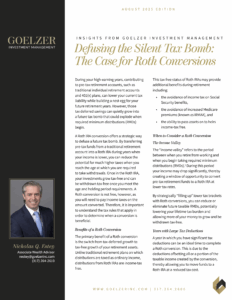
Nicholas Q. Estey
Associate Wealth Advisor

Associate Wealth Advisor
 During your high-earning years, contributing to pre-tax retirement accounts, such as traditional individual retirement accounts and 401(k) plans, can lower your current tax liability while building a nest egg for your future retirement years. However, those tax deferred savings can quietly grow into a future tax bomb that could explode when required minimum distributions (RMDs) begin.
During your high-earning years, contributing to pre-tax retirement accounts, such as traditional individual retirement accounts and 401(k) plans, can lower your current tax liability while building a nest egg for your future retirement years. However, those tax deferred savings can quietly grow into a future tax bomb that could explode when required minimum distributions (RMDs) begin.
A Roth IRA conversion offers a strategic way to defuse a future tax bomb. By transferring pre-tax funds from a traditional retirement account into a Roth IRA during years when your income is lower, you can reduce the potential for much higher taxes when you reach the age at which you are required to take withdrawals. Once in the Roth IRA, your investments grow tax-free and can be withdrawn tax-free once you meet the age and holding period requirements. A Roth conversion is not free, however, as you will need to pay income taxes on the amount converted. Therefore, it is important to understand the tax rules that apply in order to determine when a conversion is beneficial.
The primary benefit of a Roth conversion is the switch from tax-deferred growth to tax-free growth of your retirement assets. Unlike traditional retirement plans on which distributions are taxed as ordinary income, distributions from Roth IRAs are income-tax free.
This tax-free status of Roth IRAs may provide additional benefits during retirement including:
The “income valley” refers to the period between when you retire from working and when you begin taking required minimum distributions (RMDs).1 During this period your income may drop significantly, thereby creating a window of opportunity to convert pre-tax retirement funds to a Roth IRA at lower tax rates.
By strategically “filling up” lower tax brackets with Roth conversions, you can reduce or eliminate future taxable RMDs, potentially lowering your lifetime tax burden and allowing more of your money to grow and be withdrawn tax-free.
A year in which you have significant tax deductions can be an ideal time to complete a Roth conversion. This is due to the deductions offsetting all or a portion of the taxable income created by the conversion, thereby allowing you to move funds to a Roth IRA at a reduced tax cost.
In the same way that large tax deductions can offset the cost of a Roth conversion, so can losses from a business or real estate. If you know that you will experience losses from your business or real estate holdings, that is an excellent time to consider a Roth conversion.
Market declines create a unique opportunity for Roth conversions. When investment values temporarily decline, you can convert your retirement assets at a lower dollar value, thereby resulting in a smaller tax bill. As the market recovers, those converted assets will grow tax free within the Roth IRA, amplifying the long-term benefit of the conversion.
If your income level places you in a higher tax bracket, a Roth conversion may be inefficient. Converting now may cause you to pay higher tax rates than you would pay on future withdrawals, potentially costing you more in taxes over your lifetime.
Additionally, if you plan to leave your pre-tax assets to someone who will likely be able to take distributions at a lower tax rate, then paying taxes now at a higher rate would be disadvantageous.
Converting to a Roth IRA triggers ordinary income taxes on the full amount converted. Using part of the converted funds to pay those taxes reduces the amount that remains invested to grow tax-free. To maximize the long-term benefits of the conversion, we recommend that you pay the taxes from non-retirement funds.
Roth IRAs are subject to a 5-year holding requirement before you can take tax-free withdrawals. This rule excludes principal amounts contributed. If you should need to withdraw the full amount of your Roth IRA within five years, a portion of those withdrawals may be subject to both taxes and penalties.
If you plan to leave your pre-tax retirement assets to a qualified charity, a Roth conversion usually does not make sense. Charities are tax-exempt and do not pay taxes on retirement assets received, including pre-tax IRA distributions. By converting those funds, you would pay taxes the charity would not owe—creating an unnecessary tax cost.
A Roth conversion increases your taxable income in the year it is completed, which can push you into a higher tax bracket. The increase in income may result in the reduction or loss of certain tax deductions, credits, or income-based subsidies.
Additionally, if you are receiving Medicare benefits, the increased income may trigger higher Medicare Part B and D premiums through IRMAA (Income-Related Monthly Adjustment Amount) surcharges in future years.
If you have both pre-tax and after-tax IRA funds, the IRS aggregation rule requires you to treat all of your traditional, SEP, and SIMPLE IRAs as one combined account when calculating taxes on a Roth conversion. Thus, you cannot simply choose the account that would result in the lowest tax.
The passage of the One Big Beautiful Bill Act (OBBBA) on July 4, did not directly impact Roth conversions; however, with several deductions phasing out at certain income levels, further consideration is warranted.
The OBBBA added a new senior deduction ($6,000 for single filers and $12,000 for joint filers) for those 65 and older starting in 2025 through 2028. This deduction phases out between $75,000 and $175,000 of modified adjusted gross income for single filers and $150,000 and $250,000 for joint filers. If you fall in the phaseout range, every additional $1,000 of a Roth conversion could reduce your enhanced senior deduction by 1% ($60 for single and $120 for joint).
For those who itemize, the OBBBA also increased the state and local tax (SALT) deduction cap to $40,000 through 2029. This deduction could make a Roth conversion more appealing for some, but the added income from a Roth conversion could also reduce its benefit if modified adjusted gross income is pushed into the phaseout range (between $500,000 and $600,000 in modified adjusted gross income), where the SALT deduction cap gradually reduces to $10,000.
The silent tax bomb hidden within traditional retirement accounts can catch many retirees by surprise. A Roth conversion can offer a strategic opportunity to defuse that risk. By taking steps to reduce future RMDs and create tax-free income in retirement, you can take greater control of your financial future. As with any strategy, success depends on thoughtful planning. Speak with both your Goelzer financial advisor and tax professional to determine if a Roth conversion is right for you—because a smart move today could mean a more tax-efficient tomorrow.
1 Under IRS rules, required minimum distributions (RMDs) start during the year you reach age 73 (if born between 1951 and 1959) and age 75 (if born in 1960 or thereafter).
DISCLAIMER: The information provided in this piece should not be considered as a recommendation to buy, sell or hold any particular security. This report includes candid statements and observations regarding investment strategies, individual securities, and economic and market conditions; however, there is no guarantee that these statements, opinions, or forecasts will prove to be correct. Actual results may differ materially from those we anticipate. The views and strategies described in the piece may not be suitable to all readers and are subject to change without notice. You should not place undue reliance on forward-looking statements, which are current as of the date of this report. The information is not intended to provide and should not be relied on for accounting, legal, and tax advice or investment recommendations. Investing in stocks involves risk, including loss of principal. Past performance is not a guarantee of future results.
ABOUT GOELZER: With over 50 years of experience and more than $3.5 billion in assets under advisement, Goelzer Investment Management is an investment advisory firm that leverages our proprietary investment and financial planning strategies to help successful families and institutions Dream, Invest, and Live.